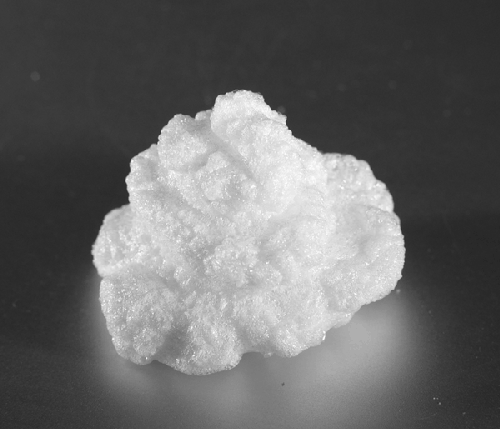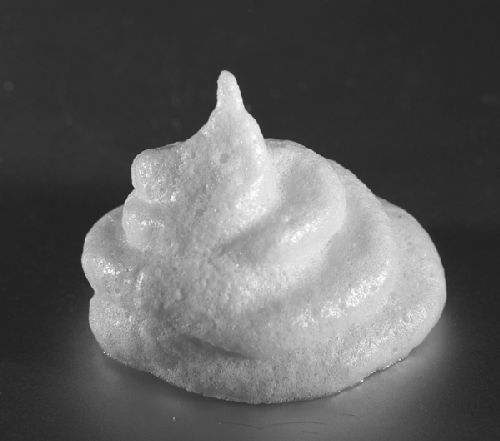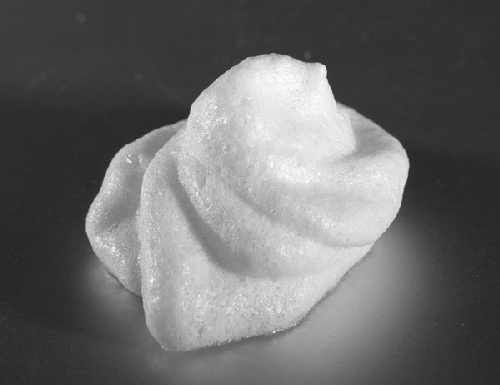6. Anti-Sugar: Lactisole
This one is unusual. Unlike the modern additives covered so
far, which have essentially focused on either trapping liquids in a gel structure or
changing the physical state of food, “anti-sugar” is an additive used to modify a flavor
sensation: it reduces the sensation of sweetness. (And no, mixing sugar and anti-sugar
does not result in more energy being released than eating just plain sugar.)
One of the challenges facing the food industry is the need to maximize shelf stability
and storage potential while maintaining acceptable flavor and texture. Sugar is used in
confections and sweets not just for its sweetness, but also as a preservative: because
sugar “latches” on to water, it reduces the amount of water available in a food product
for bacterial growth.
In the mid-1990s, Domino Sugar researched chemical modifiers that would reduce the
perception of sweetness. The compound lactisole—a carboxylic acid salt—happens to do just
that: add it to your foods at a concentration of around 100 parts per million (ppm), and
goodbye sweet sensation, as it interferes with your taste buds (the TAS1R3 sweet protein
receptor, for you bio geeks). Unlike traditional methods of dampening sweetness in a dish
(i.e., adding bitter or sour ingredients), lactisole works by inhibiting the sensation of
sweetness on the tongue, so it does not impact perception of saltiness, bitterness, or
sourness. Sadly, you can’t add it to foods to remove the calories from sugar.
Domino sells a product called Super Envision® that is a blend of mostly sucrose, some
maltodextrin, and “artificial flavor” at 10,000 ppm. It’s meant to be used at around a 1%
concentration in the final product, so the 10,000 ppm becomes 100 ppm. (Gee, I wonder if
that “artificial flavor” could be lactisole?)
Try tasting “anti-sugar” in caramel sauce . Add a small quantity of
Domino Super Envision to one bowl of caramel sauce, leaving a second bowl of caramel
unmodified for comparison’s sake. The taste of the burnt compounds in the caramel
sauce will be stronger in the adulterated bowl, because the sweet sensations won’t
be masking them.

With lactisole, what was once perishable can be mass manufactured without the same
worries about spoilage by increasing the amount of sugar and then canceling out the
additional perceived sweetness. Some jams and jellies, for example, need a certain level
of sugar to remain shelf-stable. Super Envision also shows up in products such as salad
dressings, in which sweetness from stabilizers or thickeners would be undesirable, and in
some mass-manufactured breads. Pizza dough, when baked, is more visually appealing if it
turns golden brown. Adding sugar is an easy way to get a browning reaction, but sweet
pizza dough isn’t so appealing.
Without sugar, meringues—well,
egg whites—bake into a dry brittle foam that resembles Cheetos (but without the
flavor): it’s extremely crunchy and, without any flavorings, not particularly
pleasant. When sugar is added, the meringue turns into something light, slightly
chewy, and delightful.
Try the following experiment to understand how sugar helps stabilize meringues and
how lactisole masks the sweetness.
Start by separating six egg whites into a bowl and whipping to stiff peaks. Using a
scale, weigh out into three small glass or metal bowls:
Standard meringues
50g whisked egg white
20g granulated sugar
Meringues sans sugar
50g whisked egg white
Meringues with “anti-sugar”
50g whisked egg white
20g granulated sugar
1g Domino Super Envision
Transfer each batch into a piping bag. (A plastic bag with a small cut in the corner
works well.) Pipe onto a Silpat or a cookie sheet lined with parchment paper.
Note:
Add in chopped nuts, dried fruit, and/or chocolate chips to extend it. Try dipping
the baked meringue in tempered chocolate as well.
Bake the meringues in an oven set to 200°F / 95°C for several hours, until dry.
(Trying this in the evening? You can set your oven to ~300°F / 150°C, pop the cookies
in, and then turn the oven off and come back the next morning.)
Note:
Don’t try baking meringues directly on the cookie sheet. Proteins are very sticky
and will bind to it, making it hard to remove them without breaking them. Because it’s
flexible, the Silpat or parchment paper can easily be peeled off the back of the
cooked meringues.
You can see the difference instantly in the “meringue” made without sugar: the egg
white doesn’t flow as smoothly out of the piping bag. The standard and anti-sugar
meringues have the same texture, but the taste of the standard one is, as expected,
sweet. The anti-sugar one tastes pretty much like nothing, as egg white doesn’t carry a
strong flavor of its own.
Meringues sans sugar.

Standard meringues.

Anti-sugar meringues.
